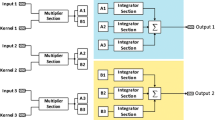Abstract
In the course of designing an integrated system for locating the focus of expansion (FOE) from a sequence of images taken while a camera is translating, a variety of direct motion vision algorithms based on image brightness gradients have been studied (McQuirk, 1991, 1996b). The location of the FOE is the intersection of the translation vector of the camera with the image plane, and hence gives the direction of camera motion. This paper describes two approaches that appeared promising for analog very large scale integrated (VLSI) circuit implementation. In particular, two algorithms based on these approaches are compared with respect to bias, robustness to noise, and suitability for realization in analog VLSI. From these results, one algorithm was chosen for implementation. This paper also briefly discuss the real-time analog CMOS/CCD VLSI architecture realized in the FOE chip.
Similar content being viewed by others
References
Bruss, A. and Horn, B. 1983. Passive navigation. Computer Vision, Graphics, and Image Processing, 21(1):3-20.
Dron, L. 1993. The multi-scale veto model: A two-stage analog network for edge detection and image reconstruction. International Journal of Computer Vision, 11(1):45-61.
Fleming, W. 1965. Functions of Several Variables. AddisonWesley: Reading, MA.
Gilbert, B. 1968. A precise four-quadrant multiplier with subnanosecond response. IEEE Journal of Solid-State Circuits, SC-3(4):365-373.
Hakkarainen, J. and Lee, H. 1993. A 40 × 40 CCD/CMOS absolutevalue-of-difference processor for use in a stereo vision system. IEEE Journal of Solid-State Circuits, 28(7):799-807.
Horn, B. 1986. Robot Vision. MIT Press: Cambridge, MA.
Horn, B. 1990. Parallel networks for machine vision. In Artificial Intelligence at MIT: Expanding Frontiers, P. Winston and S.A. Shellard (Eds.), MIT Press: Cambridge, MA, vol.2, chap. 43, pp. 530-573.
Horn, B. and Schunk, B. 1981. Determining optical flow. Artificial Intelligence, 16(1-3):185-203.
Horn, B. and Weldon, E. 1988. Direct methods for recovering motion. International Journal of Computer Vision, 2(1):51-76.
Jain, R. 1983. Direct computation of the focus of expansion. {tiIEEE Transactions on Pattern Analysis and Machine Intelligence}, 21(1).
Keast, C. and Sodini, C. 1993. A CCD/CMOS-based imager with integrated focal plane signal processing. IEEE Journal of Solid-State Circuits, 28(4):431-437.
McQuirk, I. 1991. Direct methods for estimating the focus of expansion. Master’s Thesis, Massachusetts Institute of Technology, Cambridge, MA.
McQuirk, I. 1996a. An analog VLSI chip for estimating the focus of expansion. AI Technical Report 1577, The MIT Artificial Intelligence Laboratory, Cambridge, MA.
McQuirk, I. 1996b. An analog VLSI chip for estimating the focus of expansion. Ph.D Thesis, Massachusetts Institute of Technology, Cambridge, MA.
McQuirk, I. 1997. An Analog VLSI Chip for Estimating the Focus of Expansion. In 1997 ISSCC Digest of Technical Papers, pp. 24-25.
Negahdaripour, S. and Horn, B. 1986. Direct passive navigation: Analytical solution for planes. In Proceedings of the IEEE International Conference on Robotics and Automation, Washington, DC, IEEE Computer Society Press.
Negahdaripour, S. and Horn, B. 1987a. Direct passive navigation. IEEE Transactions on Pattern Analysis and Machine Intelligence, 9(1):168-176.
Negahdaripour, S. and Horn, B. 1987b. Using depth-is-positive constraint to recover translational motion. In Proceedings of theWorkshop on Computer Vision, Miami Beach, FL.
Standley, D. 1991. An object position and orientation IC with embedded imager. IEEE Journal of Solid-State Circuits, 26(12):1853-1859.
Stein, G.P. 1993. Internal camera calibration using rotation and geometric shapes. Master’s Thesis, Massachusetts Institute of Technology, Cambridge, MA.
Tanner, J. and Mead, C. 1986. An integrated optical motion sensor. In VLSI Signal Processing II, Proceedings of the ASSP Conference on VLSI Signal Processing, University of California, Los Angeles, pp. 59-76.
Umminger, C. and Sodini, C. 1995. An integrated analog sensor for automatic alignment. IEEE Journal of Solid-State Circuits, 30(12):1382-1390.
Varga, R. 1962. Matrix Iterative Analysis. Prentice-Hall: Englewood Cliffs, NJ.
Yang, W. and Chiang, A. 1990. A full fill-factor CCD imager with integrated signal processors. In 1990 ISSCC Digest of Technical Papers, pp. 218-219.
Author information
Authors and Affiliations
Rights and permissions
About this article
Cite this article
McQuirk, I.S., Horn, B.K., Lee, HS. et al. Estimating the Focus of Expansion in Analog VLSI. International Journal of Computer Vision 28, 261–277 (1998). https://doi.org/10.1023/A:1008009805554
Issue Date:
DOI: https://doi.org/10.1023/A:1008009805554




